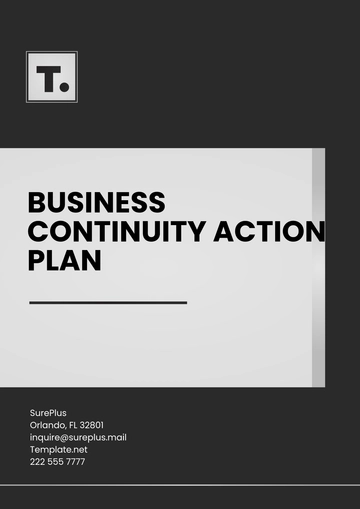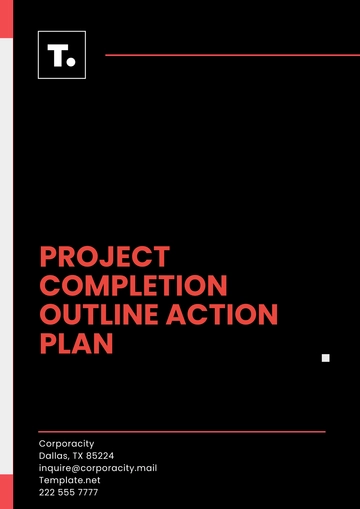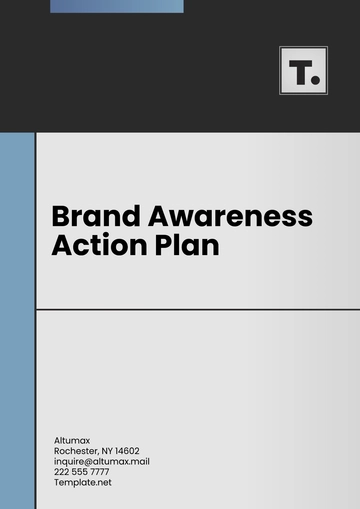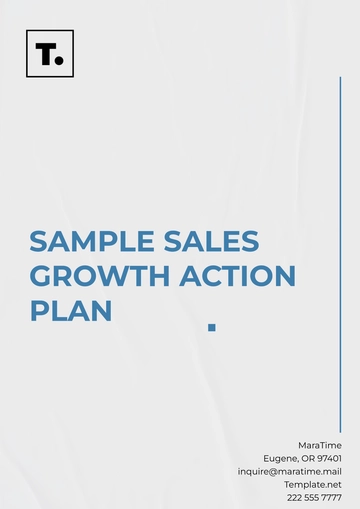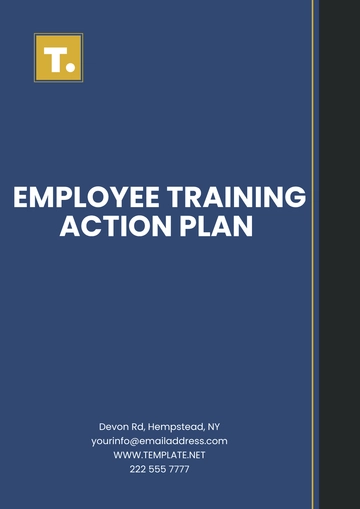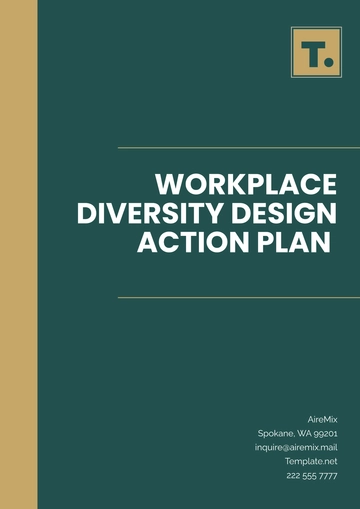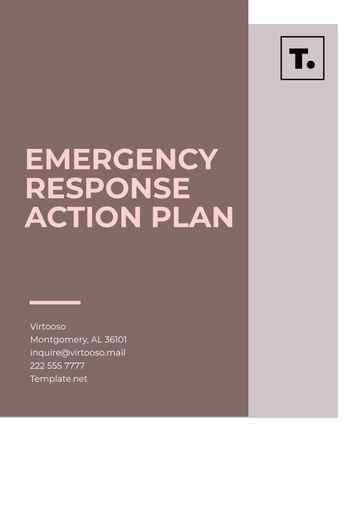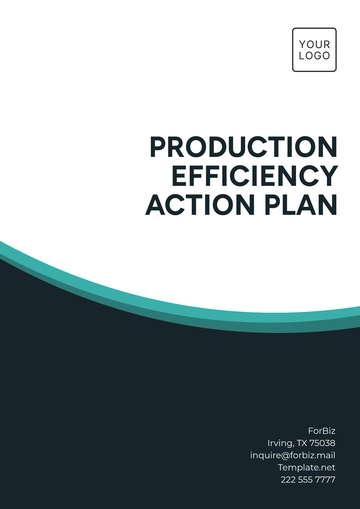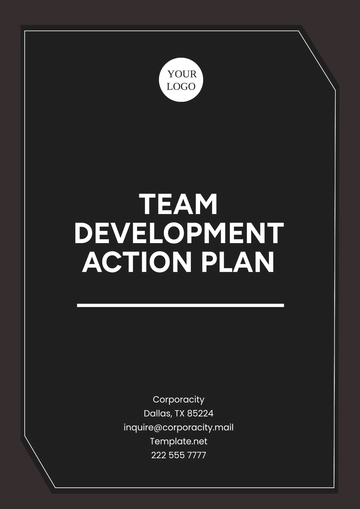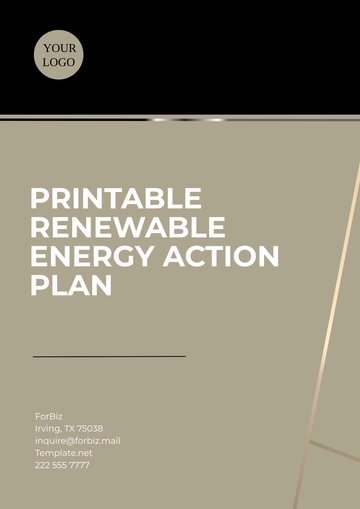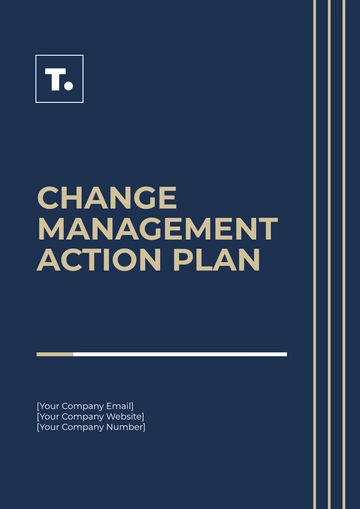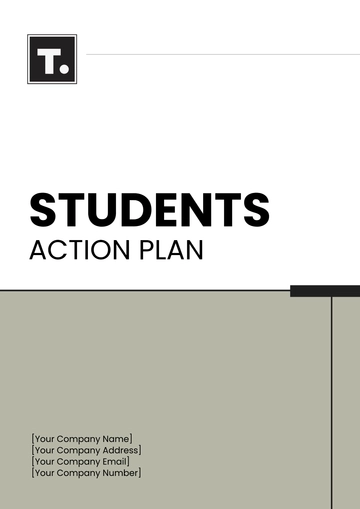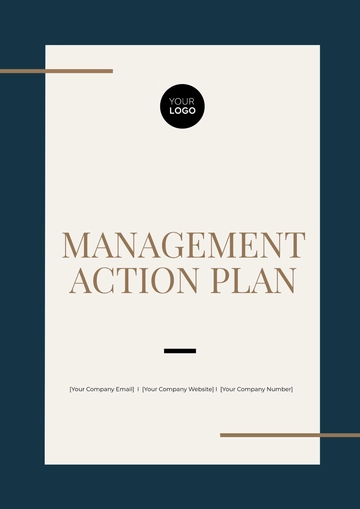Free Manufacturing Action Plan
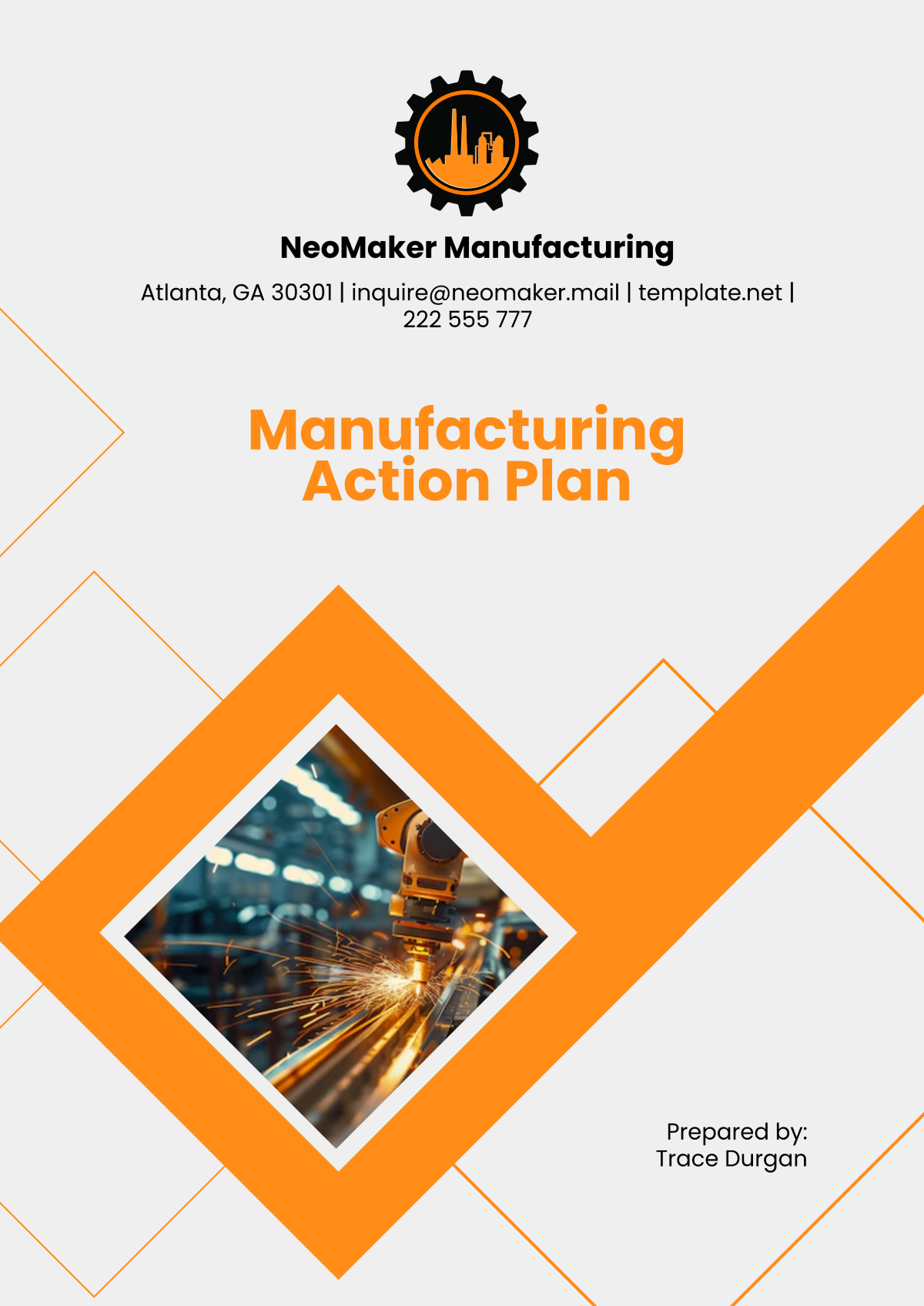
1. Executive Summary
The manufacturing industry is undergoing rapid transformation due to innovations in automation, artificial intelligence (AI), and sustainable practices. [Your Company Name] understands that adapting to these changes is critical to remaining competitive and achieving long-term success. This Manufacturing Action Plan (MAP) has been developed to ensure that our production processes are optimized for maximum efficiency, cost-effectiveness, and sustainability.
The action plan outlines a series of steps designed to improve our manufacturing capabilities, reduce operational costs, and contribute to a more sustainable future. By integrating new technologies and methodologies, we aim to enhance product quality, reduce environmental impact, and meet the growing demand for smarter, more flexible manufacturing solutions.
This plan covers multiple aspects, including process improvements, technological advancements, workforce development, and supply chain optimization. It has been designed not only to address immediate operational challenges but also to lay the groundwork for future growth. The action plan is structured to achieve tangible results within a defined timeline, with clear objectives, responsibilities, and success metrics to track progress.
2. Objectives and Goals
2.1 Primary Objectives
Increase Manufacturing Output:
To maintain competitive advantage in the industry, we must expand our manufacturing capacity. The plan targets a [25]% increase in production by the year [2052], achieved through equipment upgrades, automation, and more efficient workflows. A key area of focus will be optimizing existing lines to reduce downtime and improve throughput.Enhance Product Quality:
In a competitive market, quality is paramount. By setting a target to achieve a defect rate of less than [0.5]%, we aim to ensure that each product meets the highest standards. This will be achieved through a combination of improved quality control, automated inspection systems, and regular audits of production processes to identify areas of improvement.Adopt Sustainable Practices:
[Your Company Name] is committed to contributing positively to the environment by reducing carbon emissions. Our sustainability targets include reducing emissions by [30]% by [2055] and transitioning [50]% of our energy consumption to renewable sources by [2053]. These actions are part of our broader commitment to being a responsible corporate entity, which also includes reducing waste and optimizing energy use in all aspects of production.Improve Cost Efficiency:
A reduction in overall production costs by [10]% will be achieved by integrating smart manufacturing solutions, streamlining processes, and cutting waste. Technologies such as AI-driven predictive maintenance will help reduce downtime, and smart inventory management systems will minimize excess stock, both of which contribute to cost savings.
2.2 Long-Term Goals
Industry Leadership by 2060:
By the year [2060], [Your Company Name] aspires to become a recognized leader in advanced manufacturing, setting benchmarks for efficiency, sustainability, and product innovation. This ambition will require continuous investment in cutting-edge technologies and practices, as well as cultivating an agile and responsive workforce that can adapt to emerging trends.Diversified and Resilient Supply Chain:
The global supply chain is increasingly subject to disruptions from various sources, including geopolitical instability, climate change, and pandemics. Our goal is to build a more resilient and diversified supply chain that can better withstand these disruptions while also reducing reliance on a few key suppliers. We aim to establish relationships with at least [10] new suppliers by [2055] to ensure a stable and flexible supply chain.Full Automation of Non-Critical Processes by 2065:
Achieving full automation in non-critical production processes is a major goal. This includes automating routine tasks such as packaging, sorting, and basic assembly, which will free up human resources for more complex and high-value activities. The goal is to reach [85]% automation in these processes by [2065].
3. Current State Analysis
3.1 Operational Strengths
State-of-the-Art Facilities:
[Your Company Name] operates in modern manufacturing plants that are equipped with advanced machinery and production systems. These facilities provide the flexibility needed to support diverse product lines and meet the demands of different industries. The current infrastructure is capable of supporting high-volume production while maintaining flexibility for custom orders.Skilled Workforce:
One of the greatest assets of [Your Company Name] is its skilled and experienced workforce. Approximately [80]% of employees are trained in the latest manufacturing techniques, including lean production, Six Sigma methodologies, and digital tools. This ensures that the workforce is adaptable and capable of implementing new systems and processes efficiently.Strong Market Position:
[Your Company Name] holds a solid position in the market, with a [15]% market share in its respective industry. Our strong reputation for quality and customer service has helped build lasting relationships with clients, giving us a competitive edge in securing new contracts and expanding into new markets.Product Diversity:
Our extensive product portfolio caters to several industries, including automotive, consumer electronics, and industrial equipment. This diversification allows us to reduce dependency on a single market and helps mitigate risks associated with market volatility.
3.2 Identified Weaknesses
Limited Automation:
Despite having modern production facilities, [Your Company Name] still relies on manual processes for certain aspects of production. This includes assembly and quality inspection, which can introduce inefficiencies and increase the likelihood of errors. Approximately [35]% of our production processes are still manual, and addressing this gap through automation will be a key part of our action plan.Energy-Intensive Operations:
The current energy model is heavily dependent on non-renewable sources, resulting in high energy costs and a larger carbon footprint. This reliance on traditional energy sources increases operational costs and hinders our sustainability efforts. Our goal is to reduce energy consumption through the installation of energy-efficient equipment and a transition to renewable energy sources.Supply Chain Vulnerabilities:
[Your Company Name]'s supply chain is somewhat concentrated, with a significant portion of key materials sourced from a limited number of suppliers. This leaves the company vulnerable to supply chain disruptions, which could affect production schedules and customer commitments. Diversifying suppliers and increasing local sourcing are critical steps in mitigating these risks.Aging Equipment:
A portion of our manufacturing equipment is outdated and requires frequent maintenance. Approximately [20]% of our machines are over [15] years old, which results in increased downtime and reduced efficiency. An upgrade to modern, more reliable machinery is necessary to maintain high levels of productivity and reduce maintenance costs.
4. Strategic Action Plans
4.1 Production Optimization Strategies
Lean Manufacturing Principles:
Lean manufacturing focuses on maximizing value while minimizing waste. By implementing lean principles such as continuous flow, 5S (Sort, Set in Order, Shine, Standardize, Sustain), and Total Productive Maintenance (TPM), we will eliminate inefficiencies and enhance the overall productivity of our operations. Regular audits will be conducted to assess process flows and identify areas for improvement.Process Automation:
Automation is essential to reducing human error, increasing speed, and maintaining consistency in production. Robotic Process Automation (RPA) will be introduced in critical areas of assembly, material handling, and packaging. Furthermore, the installation of automated inspection systems will ensure higher precision in quality control.Data-Driven Decision-Making:
Integrating Internet of Things (IoT) sensors throughout the production line will provide real-time data on machine performance, inventory levels, and production outputs. By analyzing this data through AI-powered platforms, we will be able to predict maintenance needs, optimize production schedules, and avoid costly downtimes. Predictive maintenance will decrease unscheduled downtime by approximately [12]%, leading to a more efficient and cost-effective operation.
4.2 Technological Upgrades
Smart Manufacturing Systems:
The integration of AI-driven smart manufacturing systems will enable real-time monitoring of production processes and facilitate proactive decision-making. These systems can automatically adjust production parameters to optimize efficiency and reduce waste.Digital Twin Technology:
Digital twins, or virtual representations of physical manufacturing systems, will be utilized to simulate and test changes before implementing them on the production floor. This technology will reduce the risks associated with system changes and allow for continuous improvement without interrupting production.3D Printing:
Additive manufacturing, or 3D printing, will be incorporated into the production process for rapid prototyping, small-batch production, and the creation of custom components. This technology will enable faster product development cycles and reduce reliance on external suppliers for certain parts.Green Technology Integration:
To reduce energy consumption and environmental impact, we will implement energy-efficient machinery and systems, such as LED lighting, automated HVAC systems, and energy recovery units. These changes are expected to reduce our overall energy consumption by [20]%, contributing to cost savings and sustainability goals.
4.3 Workforce Development
Upskilling Programs:
Continuous education and training are essential for maintaining a workforce that is capable of utilizing the latest technologies and methodologies. [Your Company Name] will offer annual training programs to upskill employees in advanced manufacturing techniques, such as automation, robotics, and data analytics. The target is to train [50]% of employees each year.Cross-Functional Teams:
Encouraging collaboration between different departments will foster innovation and streamline problem-solving processes. Cross-functional teams will be formed to tackle specific production challenges, from design and engineering to quality control and logistics.Employee Incentive Programs:
To motivate employees and encourage high performance, [Your Company Name] will implement performance-based bonuses and recognition programs. These initiatives will reward employees who contribute to improving productivity, safety, and quality standards.
4.4 Supply Chain Enhancements
Supplier Diversification:
We will expand our supplier base by contracting with at least [10] new suppliers over the next [5] years. This will reduce the risks associated with relying on a few suppliers and ensure a more flexible and reliable supply chain.Blockchain Implementation:
The use of blockchain technology will enhance transparency in our supply chain. Blockchain will provide a secure and traceable way to monitor the movement of goods from suppliers to the manufacturing floor, reducing the risk of fraud and ensuring compliance with regulatory standards.Local Sourcing:
By increasing local sourcing by [20]%, we aim to reduce transportation costs, improve lead times, and minimize supply chain risks. Sourcing from local suppliers also supports regional economies and reduces the environmental impact of long-distance shipping.
5. Implementation Timeline
The implementation timeline for the Manufacturing Action Plan (MAP) is designed to ensure the systematic and structured achievement of all identified goals, ensuring each milestone is met within a specific timeframe. The following is the proposed timeline for key phases of the plan.
5.1 Timeline Overview
The action plan will be executed in five primary phases: Planning, Upgrades, Training, Sustainability Initiatives, and Optimization. Each phase is designed to build on the progress made in previous phases, ensuring that improvements are incremental, manageable, and sustainable. The entire plan will span from [2050] through [2055], with a longer-term perspective on full optimization and continuous improvement extending into [2060].
Phase | Milestone | Description | Target Completion Year |
|---|---|---|---|
Phase 1: Planning | Finalize action plan details | Finalize all strategies, actions, and resources needed for implementation. | 2050 |
Phase 2: Upgrades | Installation of automation systems | Begin installation of automated machines, sensors, and robotic arms for production. | 2051 |
Phase 3: Training | Conduct employee upskilling programs | Offer training for all employees to build skills in automation, data analysis, and lean principles. | 2052 |
Phase 4: Sustainability | Achieve 50% renewable energy use | Begin transitioning to renewable energy sources, ensuring at least [50]% of total energy consumption comes from sustainable sources. | 2053 |
Phase 5: Optimization | Reduce defect rates to below 0.5% | Achieve significant reductions in production defects and implement predictive maintenance tools. | 2055 |
Phase 6: Industry Leadership | Become a market leader in manufacturing | Ensure that the processes and technologies put in place have positioned [Your Company Name] as a leader in manufacturing by [2060]. | 2060 |
5.2 Key Milestones and Dependencies
To ensure the success of this plan, it’s essential that each phase is completed according to the outlined timeline. Some phases are dependent on the successful execution of previous phases. For example, the training programs (Phase 3) cannot begin until the automation systems (Phase 2) are successfully installed, as employees need to be trained on new technologies.
Critical Milestone Dependencies
Phase 2: Upgrades must be completed on schedule to ensure that Phase 3 (training) can begin. Delays in Phase 2 could push back training schedules, causing a domino effect on the overall plan.
Phase 3: Training is vital for the full utilization of new technologies introduced in Phase 2. Delays here could result in a lack of skilled workers capable of operating advanced machinery.
Phase 4: Sustainability Initiatives will require close coordination with external renewable energy providers. Any delays in securing long-term renewable contracts could push back this phase.
5.3 Resource Allocation
Adequate resources must be allocated for each phase to ensure that all tasks are completed on time. This includes human resources, budget allocation, and necessary equipment. For example, in Phase 2, the automation systems will require both financial investment and coordination with external vendors for timely delivery and installation. Similarly, Phase 3 will require investment in training programs, materials, and external instructors.
6. Budget Allocation
A critical aspect of executing this action plan is the proper allocation of the budget to ensure that all projects are adequately funded and resourced. Below is a detailed breakdown of the proposed budget for each component of the Manufacturing Action Plan.
6.1 Budget Overview
The total estimated cost of implementing the Manufacturing Action Plan is [$32,000,000], which includes investments in equipment, workforce development, technological upgrades, and sustainability initiatives. The table below provides a detailed breakdown of the budget by category.
Category | Projected Cost | Description |
|---|---|---|
Equipment Upgrades | $15,000,000 | This includes costs for purchasing and installing automation systems, robotic arms, IoT sensors, and upgrading aging equipment. |
Employee Training | $3,000,000 | Funding for the development and execution of training programs on automation, lean manufacturing, and quality management for all employees. |
R&D Initiatives | $5,000,000 | This budget will cover the costs of developing and testing new technologies for production optimization, including AI-driven data analytics platforms. |
Sustainability Projects | $7,000,000 | Includes investments in renewable energy sources, such as solar panels, wind turbines, and energy-efficient systems to reduce energy consumption. |
Contingency Fund | $2,000,000 | Reserved for unexpected costs, such as delays, unforeseen maintenance, and market fluctuations. |
Total | $32,000,000 |
6.2 Budget Justification
Each component of the budget has been carefully considered to ensure that the Manufacturing Action Plan remains fully funded. The largest portion of the budget—[$15,000,000]—will go toward upgrading equipment and automating critical aspects of the production process. This investment is expected to yield significant cost savings in the long term by reducing manual labor costs, increasing production efficiency, and improving product consistency.
Employee training, which accounts for [$3,000,000], is essential for the successful implementation of new technologies. Investing in our workforce is essential to ensure that employees are not only capable of working with new equipment but also understand the principles behind lean manufacturing and quality control. This is vital for achieving the operational improvements we seek.
Sustainability initiatives are a priority for [Your Company Name], reflecting both the company’s environmental responsibility and long-term cost savings. [$7,000,000] will be allocated to energy efficiency projects, such as solar panel installations, energy-efficient lighting systems, and renewable energy contracts.
7. Risk Assessment and Mitigation Strategies
Successful execution of the Manufacturing Action Plan requires identifying potential risks and implementing mitigation strategies. This section outlines the most significant risks associated with the plan and the steps that will be taken to manage them effectively.
7.1 Identified Risks
Financial Constraints
The scale of the plan requires substantial investment. There is a risk that unexpected financial challenges, such as market downturns or cost overruns, could delay or derail the action plan.
Risk Probability: Moderate
Impact: HighTechnological Integration Failures
With the adoption of advanced technologies, such as automation systems and AI-powered analytics, there is a risk that these technologies may not integrate seamlessly with existing infrastructure, leading to delays in the implementation process.
Risk Probability: Low
Impact: HighSupply Chain Disruptions
Changes to the supply chain, such as delays in receiving raw materials or disruptions in supplier availability, could impact production schedules and costs.
Risk Probability: High
Impact: ModerateResistance to Change
Employees may be resistant to the changes brought about by new systems, technologies, and processes. This could lead to slower adoption rates and a temporary decline in productivity.
Risk Probability: Moderate
Impact: Moderate
7.2 Mitigation Strategies
To ensure the successful execution of the Manufacturing Action Plan, several risk mitigation strategies will be implemented.
Contingency Budget:
A contingency budget of [$2,000,000] will be maintained to manage unforeseen financial challenges and mitigate the risks associated with cost overruns or unexpected market fluctuations.Technology Partnerships and Testing:
To ensure smooth integration of new technologies, [Your Company Name] will collaborate with technology vendors and consultants to ensure that the new systems are fully compatible with existing infrastructure. A pilot testing phase will be conducted before full implementation to reduce the likelihood of technological failures.Supplier Diversification:
To reduce the risk of supply chain disruptions, we will diversify our supplier base and establish backup suppliers for critical materials. Additionally, we will explore local sourcing to minimize delays due to long-distance shipments.Change Management Program:
A robust change management program will be established to manage the transition to new systems and processes. This will include communication campaigns, training sessions, and regular feedback loops to ensure employees are well-equipped and comfortable with the changes.
8. Monitoring and Reporting Framework
The success of the Manufacturing Action Plan will be evaluated through continuous monitoring and reporting to ensure that key performance indicators (KPIs) are met. This framework will provide the necessary tools and processes to track progress, identify challenges early, and ensure that corrective actions are taken when needed.
8.1 Key Performance Indicators (KPIs)
The following KPIs will be tracked regularly to monitor the success of the Manufacturing Action Plan:
KPI | Target | Monitoring Frequency |
|---|---|---|
Production Efficiency | 25% increase in output | Monthly |
Defect Rate | Less than 0.5% | Monthly |
Energy Consumption | 20% reduction in energy usage | Quarterly |
Employee Training Completion Rate | 100% of employees trained | Annually |
On-Time Delivery Rate | 98% on-time delivery rate | Monthly |
8.2 Reporting Mechanisms
Monthly Reviews:
Monthly performance review meetings will be held with senior management to track progress against KPIs, discuss challenges, and make any necessary adjustments. These meetings will also allow for resource reallocation if any phase is behind schedule.Quarterly Reports:
A detailed report will be prepared every quarter, summarizing the progress of the Manufacturing Action Plan. This report will include financial status, progress toward sustainability goals, updates on technological integration, and the outcomes of any risk mitigation measures taken.Annual Audits:
An annual audit will be conducted to assess the overall effectiveness of the Manufacturing Action Plan. This audit will focus on the strategic alignment of the plan with the company’s goals and objectives, reviewing whether the operational improvements achieved match the company’s expectations.
9. Conclusion
[Your Company Name] is committed to successfully executing this comprehensive Manufacturing Action Plan to drive innovation, optimize operations, and lead in sustainability within the industry. Through significant investments in automation, workforce development, and sustainable energy initiatives, we are positioning ourselves for long-term success in a rapidly evolving marketplace.
By adhering to the planned timeline, maintaining budget control, and employing rigorous monitoring practices, [Your Company Name] will achieve the objectives outlined in this plan, delivering measurable improvements in productivity, cost efficiency, and environmental impact by the year [2060].
The success of this Manufacturing Action Plan will enable [Your Company Name] to remain competitive, improve stakeholder value, and provide a positive impact on the global manufacturing sector. We are confident that, with continuous commitment and focus, the goals set forth in this plan will be met and exceeded.
Prepared by:
[Your Name]
[Your Position]
[Your Company Name]
- 100% Customizable, free editor
- Access 1 Million+ Templates, photo’s & graphics
- Download or share as a template
- Click and replace photos, graphics, text, backgrounds
- Resize, crop, AI write & more
- Access advanced editor
Stay on top of your production goals with the Manufacturing Action Plan Template from Template.net. Editable and customizable, this template allows you to plan and execute strategies for improving your manufacturing processes. The AI Editor Tool enables you to adjust the plan to your company's needs, ensuring efficiency and growth.



